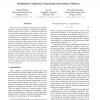Free Online Productivity Tools
i2Speak
i2Symbol
i2OCR
iTex2Img
iWeb2Print
iWeb2Shot
i2Type
iPdf2Split
iPdf2Merge
i2Bopomofo
i2Arabic
i2Style
i2Image
i2PDF
iLatex2Rtf
Sci2ools
CVPR
2008
IEEE
2008
IEEE
Radiometric calibration using temporal irradiance mixtures
We propose a new method for sampling camera response functions: temporally mixing two uncalibrated irradiances within a single camera exposure. Calibration methods rely on some known relationship between irradiance at the camera image plane and measured pixel intensities. Prior approaches use a color checker chart with known reflectances, registered images with different exposure ratios, or even the irradiance distribution along edges in images. We show that temporally blending irradiances allows us to densely sample the camera response function with known relative irradiances. Our first method computes the camera response curve using temporal mixtures of two pixel intensities on an uncalibrated computer display. The second approach makes use of temporal irradiance mixtures caused by motion blur. Both methods require only one input image, although more images can be used for improved robustness to noise or to cover more of the response curve. We show that our methods compute accurate ...
Accurate Response Functions | Camera Response Curve | Camera Response Functions | Computer Vision | CVPR 2008 | Single Camera Exposure | Temporal Irradiance Mixtures |
| Added | 12 Oct 2009 |
| Updated | 12 Oct 2009 |
| Type | Conference |
| Year | 2008 |
| Where | CVPR |
| Authors | Bennett Wilburn, Hui Xu, Yasuyuki Matsushita |
Comments (0)

